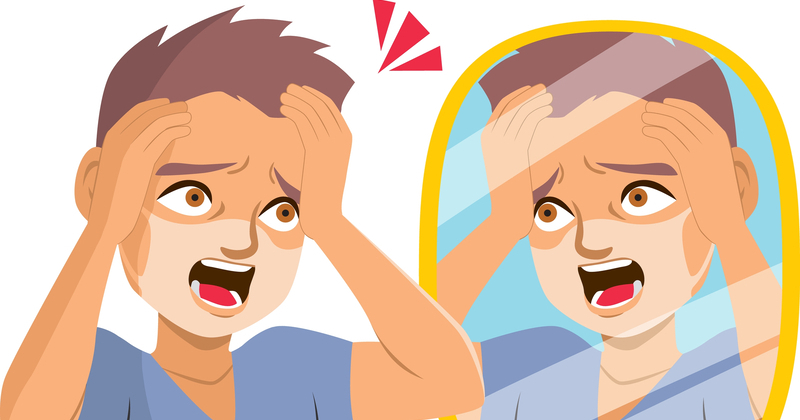Mental causes and symptoms of Body dysmorphic disorder.
Body dysmorphic disorder is a reasonably common mental health disease in which a person has excessive concern about a perceived flaw in their physical appearance. The face and hair are typically the two body parts that people with body dysmorphic disorder (BDD) worry about the most.

Anxiety over one’s lips, grin, or other physical characteristic is common. Some individuals may believe that their acne or facial hair is more obvious and serious than it actually is. Others worry that their overall appearance is unattractive.
The following are the most typical areas of worry for those with BDD:
- Skin imperfections: A few examples of skin flaws are wrinkles, scars, acne, and pimples.
- Hair: This could refer to body or head hair as well as the lack of hair.
- Facial features: Frequently, this refers to the nose, although it might also refer to the size and form of any feature on the face.
- Body weight: Sufferers may become fixated on their size or level of muscle.
The size of the penis, muscles, breasts, thighs, buttocks, and the existence of specific body odours are other areas of concern.
How does body dysmorphic disorder (BDD) affect people?
Body dysmorphic disorder sufferers may:
- They think they’re unattractive.
- Spend hours every day contemplating your apparent defects.
- They skip out on job or school because they don’t want to be seen.
- Avoid socialising with loved ones and friends.
- have plastic surgery, potentially more than one operation, to try to look better.
- extreme mental distress and destructive behaviour.
Symptoms of Body Dysmorphic Disorder
An unhealthy fixation with one or more aspects of your physical appearance is the main symptom of BDD. This could imply that you constantly judge your perceived flaw against others and struggle to focus on other tasks. Additionally, it may cause social anxiety.
Other symptoms that can emerge as a result of BDD include:
- a poor sense of self
- keeping out of social situations
- difficulties paying attention at job or school
- repeated activity to cover up imperfections, including overgrooming and getting plastic surgery
- avoidance of mirrors or compulsive mirror checking
- obsessive habits like skin plucking (excoriation)
- changing clothes frequently
The most frequently fretted about bodily parts for BDD sufferers are their face, hair, and skin. However, any bodily area might be the subject of attention. Common BDD areas of interest include:
- acne or pimples on the face
- aspects of the face, such as the nose, lips, and eyes
- hair type, thickness, or colour
- body size and composition
- genitalia
In the Diagnostic and Statistical Manual of Mental Disorders, Fifth Edition, BDD is a subset of muscle dysmorphia (DSM-5). A person in this situation is fixated with the notion that their body is too tiny or lacking in muscle. This occurs more frequently in men and is linked to a higher risk of substance abuse and suicide.
Causes of Body Dysmorphic Disorder
BDD may be caused by a number of factors, albeit the exact cause is unknown to medical professionals.
An inherited disorder
A tiny investigation has indicated that certain genetic variables might be involved. According to the study, 8 percent of those who have BDD have a close relative who has experienced the disorder.
Obsessive-compulsive disorder (OCD)
BDD frequently affects individuals with an OCD diagnosis or who have a relative who has the disease. According to one study, BDD affects 8–37% of individuals with OCD. More research is required, although BDD and OCD may share similar genetic causes. The same therapies that work for OCD also seem to work for BDD.
Visual processing and other features of the brain
In a 2004 stud where participants were given tasks including sketching figures and seeing photographs, persons with BDD were more prone than those without BDD to overfocus on details and detect distortions. Scientists continue to believe that these elements may be involved in BDD, even if it is unclear whether they are a cause or an outcome of the disorder.
Low levels of the neurotransmitter serotonin:
Low levels of the neurotransmitter serotonin have been detected in certain BDD patients, however it is unclear whether serotonin plays any role in the disorder. Serotonin appears to improve some symptoms when administered as a medication, but scientists think the connection is probably complicated.
Childhood experiences
One study suggests that BDD can develop in those who have been teased or body shamed in the past. A higher sensitivity to the ideas of harmony and beauty may potentially affect BDD, but the study cautions that this could be a symptom of the condition rather than a root cause.
More research is required to establish this, but it is possible that teaching that emphasises particular conceptions of beauty also contributes to the development of BDD.
Diagnosing BDD
BDD is classified as an obsessive-compulsive and associated disorder in the DSM-5.
To help doctors differentiate the illness from other mental disorders including social anxiety and others, the DSM-5 offers modernised diagnosis criteria. However, BDD sufferers frequently also have other anxiety problems.
The following signs and symptoms must be present for BDD to be diagnosed:
- the obsession with a “flaw” in your look
- repetitive actions, such as skin plucking, frequently changing your clothes, or mirror-gazing
- a severe disturbance in your functioning or significant distress brought on by your obsession with the “flaw”
- Although having both can occur, the BDD concern is not a direct effect of an eating disorder.
A subtype of BDD is muscle dysmorphia.
REFERENCES:
- https://www.healthline.com/health/body-dysmorphic-disorder
- https://www.medicalnewstoday.com/articles/309254
- https://www.mayoclinic.org/diseases-conditions/body-dysmorphic-disorder/symptoms-causes/syc-20353938
- https://my.clevelandclinic.org/health/diseases/9888-body-dysmorphic-disorder
- https://www.webmd.com/mental-health/mental-health-body-dysmorphic-disorder